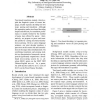Free Online Productivity Tools
i2Speak
i2Symbol
i2OCR
iTex2Img
iWeb2Print
iWeb2Shot
i2Type
iPdf2Split
iPdf2Merge
i2Bopomofo
i2Arabic
i2Style
i2Image
i2PDF
iLatex2Rtf
Sci2ools
101
click to vote
COLING
2010
2010
Joint Parsing and Translation
Tree-based translation models, which exploit the linguistic syntax of source language, usually separate decoding into two steps: parsing and translation. Although this separation makes tree-based decoding simple and efficient, its translation performance is usually limited by the number of parse trees offered by parser. Alternatively, we propose to parse and translate jointly by casting tree-based translation as parsing. Given a source-language sentence, our joint decoder produces a parse tree on the source side and a translation on the target side simultaneously. By combining translation and parsing models in a discriminative framework, our approach significantly outperforms a forest
Related Content
| Added | 13 May 2011 |
| Updated | 13 May 2011 |
| Type | Journal |
| Year | 2010 |
| Where | COLING |
| Authors | Yang Liu, Qun Liu |
Comments (0)

